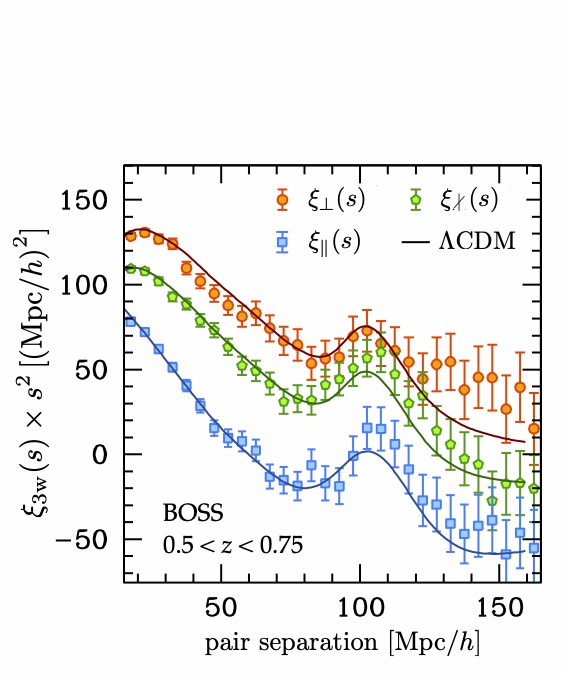
Galaxy clustering statistics
Traditionally, the most popular tools to extract the information encoded in the large-scale structure (LSS) of the universe have been two-point statistics like the correlation function, ξ(s), or its Fourier transform, the power spectrum, P(k), which characterize the probability (in excess of random) of observing pairs of galaxies as a function of their absolute separation, s. The true power of LSS observations can only be exploited by means of anisotropic clustering measurements such as the correlation function wedges. The image shows measurements of three clustering wedges from the final BOSS in the directions transverse (orange), intermediate (green) and parallel (blue) to the line of sight. The peaks visible in all wedges correspond to the signature of the baryon acoustic oscillations (BAO), a standard ruler that can be used to probe the expansion history of the Universe. The differences in amplitude and shape between the wedges are caused by gravitationally induced motions of the galaxies, referred to as redshift-space distortions (RSD), which can be used to measure the growth of cosmic structures. Thanks to the combined information of BAO and RSD, galaxy clustering measurements are one of our most powerful cosmological probes.
However, two-point statistics can only provide a complete description of the LSS of the Universe for Gaussian density fluctuations. Even though current observations constrain deviations from Gaussianity in the early Universe to be small, the non-linear evolution of the density field gives rise to a strongly non-Gaussian distribution at later times, making its description in terms of two-point statistics incomplete.
A full characterization of the density field would require measuring an infinite hierarchy of N-point correlation functions. Additional statistics that encode compressed higher-order information have been proposed as alternatives to complement the standard two-point analyses (e.g. Minkowski functionals, void-galaxy cross-correlation functions, or density-split statistics). An analysis based on a battery of cosmological tests, combining two-point measurements and additional statistics, holds the key to maximise the information extracted from galaxy redshift surveys.